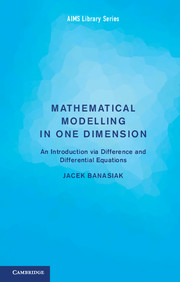3 - Basic differential equations models
Published online by Cambridge University Press: 05 March 2013
Summary
In the previous section we saw that difference equations can be used to model quite a diverse phenomena but their applicability is limited by the fact that the system should not change between subsequent time steps. These steps can vary from fractions of a second to years or centuries but they must stay fixed in the model. On the other hand, there are numerous situations when changes can occur at all times. These include the growth of populations in which breeding is not restricted to specific seasons, motion of objects, where the velocity and acceleration may change at every instant, spread of an epidemic with no restriction on infection times, and many others. In such cases it is not feasible to model the process by relating the state of the system at a particular instant to a finite number of earlier states (although this part remains as an intermediate stage of the modelling process). Instead, we have to find relations between the rates of change of quantities relevant to the process. The rates of change typically are expressed as derivatives and thus continuous time modelling leads to differential equations which involve the derivatives of the function describing the state of the system.
In what follows we shall derive several differential equation models trying to provide continuous counterparts of some discrete systems described above.
Equations related to financial mathematics
In this section we shall provide continuous counterparts of equations (2.2) and (2.5) and compare the results.
- Type
- Chapter
- Information
- Mathematical Modelling in One DimensionAn Introduction via Difference and Differential Equations, pp. 37 - 65Publisher: Cambridge University PressPrint publication year: 2013

